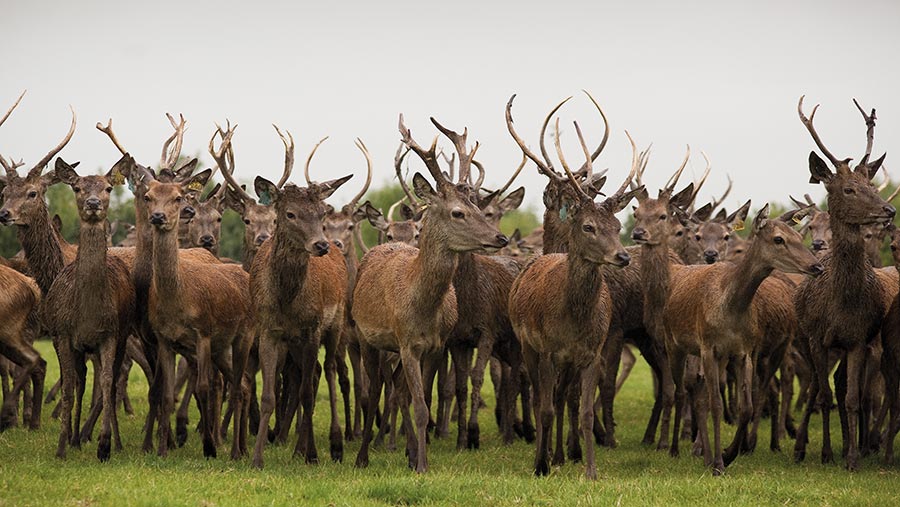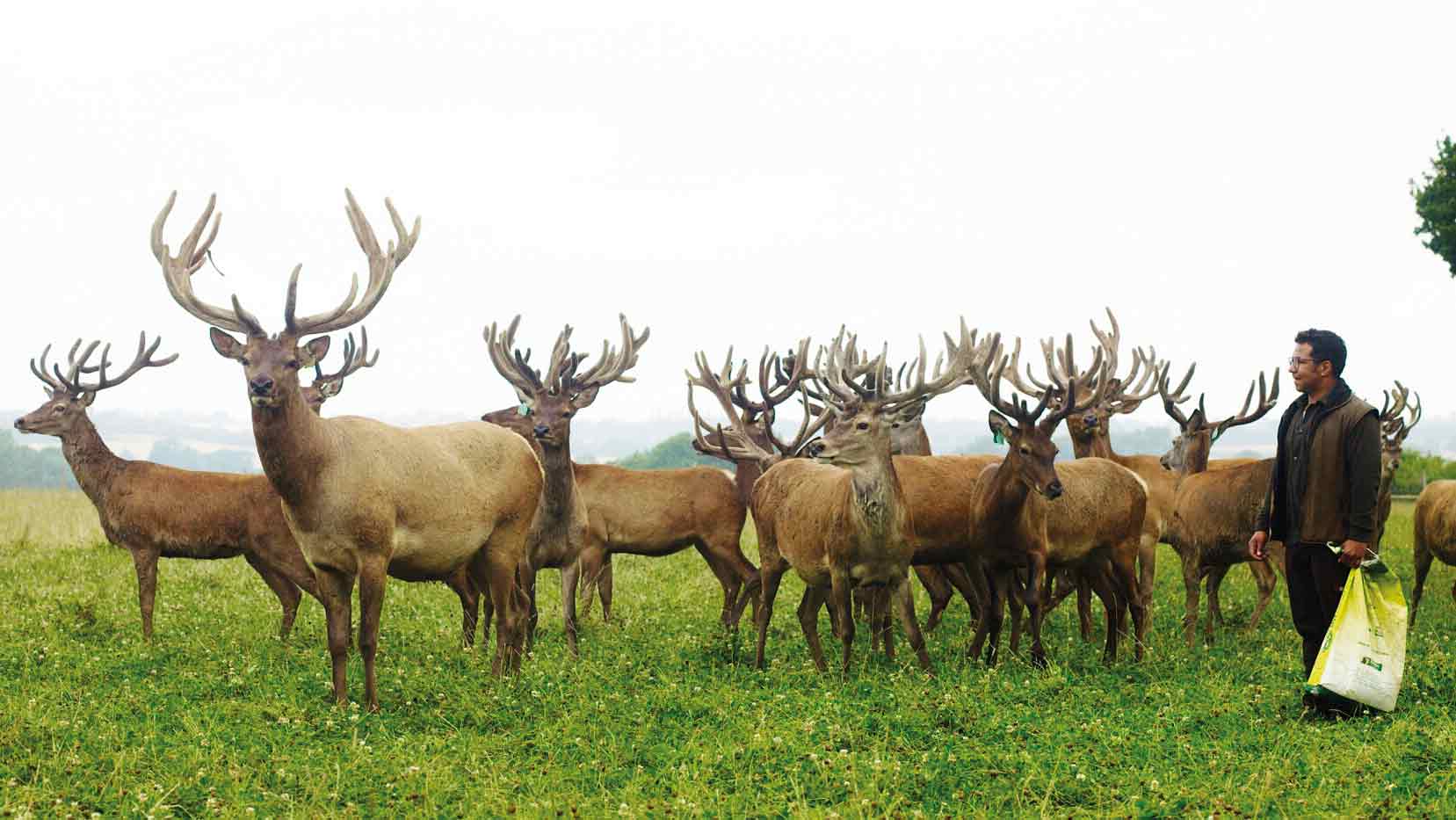So you want to… start producing venison?
 © Anthea Kitching
© Anthea Kitching New opportunities exist for commercial deer farming in the UK after a commitment by major retailers to source all own-label venison from British producers.
Waitrose and Marks & Spencer previously imported venison from New Zealand outside the British season, but they came under pressure from consumers to end sales of imported venison.
Alan Sneddon, a council member of the British Deer Farms and Parks Association and director of the Venison Advisory Service, says the new focus on domestic supply has created a strong demand for farmed venison.
See also: So you want to…offer PYO flowers?
As a consequence, Dovecote Park, a major processor of UK farmed venison, has brought forward its killing season, he says.
“This will enable them to offer chilled venison over the summer months – venison that would otherwise have been imported from New Zealand.”
An additional 8,000 carcasses a year are needed to meet this new UK demand alone.
Major retailers of farmed venison have seen growth in sales of about 20% year-on-year for the past two years, creating new opportunities for domestic production.
Data from Kantar shows that in the year to April 2022, the total annual spend within the venison market was £15.2m.
Compared with April 2019, this represented an increase of 20.3%, with volume increasing by 14.6%.
Setting up and running a deer breeding unit with 100 hinds and three stags
Capital costs
- Fencing/gates (4,260m of fencing and 11 gates): £67,200
- Handling system: £20,000
- Watering system (troughs, bases and pipework): £4,550
- Feed equipment (ring feeders and troughs): £2,450
- Livestock: £55,000
Total capital costs: £149,200 (prices as at May 2022)
Operating costs
- Forage: £9,250
- Concentrates: £3,398
- Straw: £975
- Veterinary and medicine: £550
- Water: £600
- Transport: £960
- Repairs: £400
- Miscellaneous: £400
Total operating costs: £16,533
Predicted output
- Prime sales: £32,328 (80 deer)
- Culls: £3,135 (10 deer)
- Replacements: -£3,551 (10 deer)
- Stag depreciation: -£750 (3 deer)
Total output: £31,162 (subject to confirmation of 2022/23 price and based on top 10% of producers)
- Gross margin: £14,628
- Gross margin/acre: £325.07
Source: Tom Harris, of Berrys, and the British Deer Farms and Parks Association
Deadweight prices are currently in the region of 550p/kg, with a premium paid for early sales; some buyers also pay an incremental increase of about 5p/kg a month to the end of March and a bonus on carcasses that grade at U2 and U3.
Mr Sneddon says he has confidence in the market for farmed venison, but adds a note of caution:
“If I was a potential new entrant to deer farming or any farming enterprise right now, I would be waiting to see if the new entrant/young farmers grants come back in any shape or form.”
Breeds
The most common type of deer farmed in the UK is red deer, a naturally herd-forming breed that is relatively easy to manage when born and raised within a farm environment.
Scottish-type red deer hinds are hardy, have good maternal instincts and suit more marginal ground with less inputs; an adult hind might achieve 100-110kg liveweight.
English park-type deer are generally larger at 120-125kg, and Eastern European red deer are about 125-140kg.
Mr Sneddon says these have potential for faster growth rates than the Scottish-type and suit better ground where the higher nutritional requirements can be met.
Elk are larger than the other breeds and their genetics are now available in the UK.
Mr Sneddon says with fewer venison imports and with deer farmers looking at options for early finishing, Eastern European and Elk sire stags may be one possibility for this.
Husbandry
Young deer are programmed to grow quickly in spring, therefore good pasture management will help to achieve optimal growth rates.
Similarly, lactating hinds with calves at foot need a high level of nutrition in the autumn so that calf weaning weights can be maximised, Mr Sneddon advises.
Sire stags and replacement breeding hinds are usually selected on growth rates, conformation and temperament.
“Ultrasound scanning is commonly used and non-pregnant hinds can be culled, which has a positive influence on the reproductive rate of the herd,” says Mr Sneddon.
The cull hind price is currently 400p/kg.
Case study: Tom Harris, Harris Venison & Co, Northamptonshire
An investment of £70,000 allowed Tom Harris to get a foothold in commercial deer farming six years ago.
As demand for venison has grown, so has his business, from 60 breeding hinds to the 270 he farms in Northamptonshire today.

© Tom Harris
Mr Harris has no background in farming – he had qualified as a chartered surveyor but grew up in the countryside and was ambitious to farm in his own right.
Deer farming satisfied many criteria, including its lower labour requirement compared to other livestock sectors, and its potential to generate good profit margins.
“It meant I could carry on working full-time as a chartered surveyor to keep the wolf from the door while I got started,” says Mr Harris, who is now 35.
He rented land around Towcester on farm business tenancy agreements and grazing licences, bought 60 breeding hinds and established Harris Venison & Co.
The initial set-up costs were about £70,000, but he calculates that it would have been higher had he not provided some of the labour to erect the deer-proof fencing and other infrastructure.
Through the Countryside Stewardship scheme, some of the landlords Mr Harris rented land from secured £4.90/m towards the cost of fencing.
He also got funding through that scheme for water systems and to roof over handling areas and selecting the legume and herb-rich sward option at £145/acre for some of the 170 acres he now farms.
Mr Harris says he has also benefitted enormously from having Hornby Estate’s livestock manager Simon Pike as an informal mentor.
“His knowledge and experience have been very valuable, I would advise anyone starting out to get the support of a mentor if possible.”
Mr Harris also worked on large deer farms in New Zealand to gain experience.
As his business got established, hind numbers increased, to 270 at the last count, with 530 animals in total in the closed herd.
As well as natural service, 50 hinds a year are inseminated with selected genetics and most of the male offspring are sold as breeding animals.
Females are retained to form an elite group within the herd, which then forms the nucleus for breeding replacement females.
“I sell maternal and terminal stags as two-year-olds – there is a much higher margin on these than the animals sold for meat, but it’s over a three-year process from the initial planning to selecting the best stags for sale,” says Mr Harris.
He also uses Eastern European and elk genetics, because their superior growth rates compared to a British red deer allow sales to the early, more lucrative market for venison.
Prime animals are sold from 14 to 27 months to Dovecote Park from July – with a premium paid for early animals; they can achieve carcass weights of 50-80kg depending on stage of production and the farming system.
The herd is mostly housed from November to March.
“I try to sell finished animals between July and September, and if I can get yearlings off grass by mid-August, it allows grass covers to rebuild and be managed in the right way so that there is grazing available in September and October for the rutting period.
“That makes the winter-feeding period shorter,” says Mr Harris.
He says he initially sacrificed profit to breed the correct type of animal to suit his system and objectives but that his business is now making a profit.
“It does stack up as a business, but when you are starting out in farming there are significant start-up costs and investments to make.
“Unlike my situation, a lot of existing farmers who go into farmed venison are already set up with some infrastructure so their cost base will potentially be much lower, and they are able to spread their fixed costs.”
His biggest challenge is access to capital and taking on land for a term that is long enough to warrant investment in infrastructure.
“Sometimes that risk had paid off and sometimes it hasn’t, but that is something that is unique to my own circumstances,” he says.
